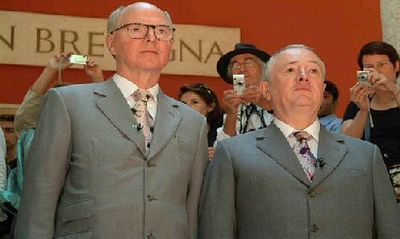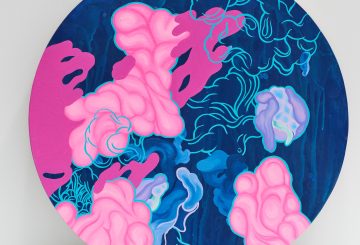The 51st Biennale of Venice is like the Royal Easter Show when it was still at Moore Park, only there are no thrilling rides, no side show alley and no fairy floss. There are pavilions, however, and show bags and folks down from the country in strange clothes that time forgot. There were a record number of participating countries this year and were numbered in a handy short guide one could buy for 6 Euros. Australia was first at Number 1 and ended with the Peoples Republic of China at Number 55.
A prize is awarded to the country whose artist is [according to a secret criterion reported to involve the intervention of the Holy Spirit and some heavy back room drinking sessions] the most significant. This year the prize went to Annette Messenger whose ostentatious and over-scaled works filled the French Pavilion in the same way the way the Atlantic filled the Titanic, except the artist used old cushions, train sets and billowing silk instead of icy water. The delicate act of transubstantiation that results in a pile of old rags becoming a metaphor of great complexity sank under the burden of all the meanings projected onto it.
Australia was represented by Ricky Swallow [born near Melbourne] and raised in the glare of attention, nourished by the rich milk of the public purse and now representing all the aspirational ambitions of a parvenu culture. Admittedly, the Australian Pavilion has been receiving considerable international press attention but as the International Herald Tribune reported it was for “the coup of having Cate Blanchett give the opening remarks“, which concluded with her observation that Swallow’s work was proof of the richness and diversity of contemporary Australian culture. Given the preponderance of old master Dutch Still Life references and shallow quotes from American Pop traditions it seemed to the largely European audience that she was reading from a script work shopped by the Australia Council that had been designed to paper over the void that has opened up between Australia as a multicultural paradise of yesteryear and the darkness of a decade of John Howard’s rule.
Blanchett may have believed what she said but it does not make it true. Swallow’s works individually possess some idiosyncratic charm but as the prominent German dealer Joerg Johnen (Johnen & Schoettle Gallery Cologne and Johnen Gallery Berlin) remarked, when exhibited in this quantity were “old fashioned, like some arts and crafts product that should have been carved in Oberammergau”. Johnen is a highly respected dealer with an international reputation, a background as an art historian and a stable of respected, innovative artists such as Thomas Ruff, Jeff Wall and also for the easy money the notorious wood carver– Stefan Balkenhohl. What makes his observation of more than passing interest is that in February Johnen was interested in Swallow, having seen his work reproduced in the magazines [that coincidentally carry advertisements for the galleries that exhibit it]. Johnen was disappointed and in this he had an abundance of very good company as not one European or American curator we spoke with found anything of real merit in the works or their Gold Coast boutique-like and overly precious installation.
There was a lot of hand made, wood based work at the Biennale both in the Arsenale curated by Rosa Martinez and in the Giardini where the older national pavilions are established. Getting the most attention was Israeli artist Guy Ben-Ner whose highly poetic tree house, assembled from turned furniture elements that, like Swallow’s sculptures, evoked a residual Baroque memory because of their elegant curves and complex joinery. The Israeli pavilion was carpeted with a heavily patterned petite bourgeois rug that reinforced the sub text of a film projected in the upper part of the exhibition area that showed the tree house being assembled by the artist as an elaborate, rather obvious metaphor for the “squatting” of the occupied territories by Jewish settlers. The work was amusing and the artist wore a hilarious fake beard and laboured mightily on his edifice.

Gilbert & George.
Gilbert and George at the British Pavilion were what you would expect – they were there, they were accessible and they were great. We would normally look upon an opportunity to comment on their work as an exercise in obsequiousness, however even the great have their bad days. In the British pavilion the crowded, slightly cloying atmosphere generated by the almost wall-to-wall photographic collages reminded us of Walter Pater’s description of the Mona Lisa’s eyes – ‘a little wear’ G&G’s attempt to contemporise topically their [now well known] images of slightly dangerous looking youths by the addition of Arabic textual components retroactively cheapened their earlier works. The installation of the Ginko series was oppressive – almost like some floral deodorant used to mask the odour of fatigue and creative exhaustion. They are great artists, tested by time – innovative, challenging and they will survive. Watching them work the crowd outside the pavilion was like observing a preternatural phenomena being replicated in a test tube and we could not but help think that one work of incontestable authority on a wall would have deepened the mystique time and the media have deposited on the singing statues as a form of everlasting patina.
There was a lot of film work present some of which deserved the attention it received and some which did not. Jeroen de Rijke and Willem de Rooij at the Netherlands Pavilion projected a film and called it an installation. Technical problems distorted the sound made sitting through its 40 minutes more than a little tedious but it was a smart white Dutch tale of power, corruption and commodity exchange in English. The Dutch accent in qualified English sounds South African and feels like you’re being sold cheap diamonds. Everyone we spoke to liked it and the circle of admirers around the curator Martijn van Nieuwenhuysen was a direct testament to its popularity. The much more enjoyable Luxembourg entry – a film shot in suburban Luxembourg utilizing a reconstructed Venice of dry canals and occasional snow flurries – was equally popular. Its protagonists were a curator, and artist and a collector, there were scenes of impressively complex dialogue but as it was in English with a French accent it seemed somehow polished with an easy sophistication.
There were several really exemplary pavilions. Singapore’s pavilion was curated by Eugene Tan who proposed a work by Lim Tzay Chuen that would have involved excising a 70 ton sculpture of a winged lion [the symbol of Singapura or Lion City] and removing it to Venice. The operation – code named MIKE – didn’t happen. Instead the pavilion consisted of two purpose built lavatories of extravagant proportions, impeccably stylish and sumptuously appointed an oblique reference to the hygienically obsessive, brand conscious and incredibly prosperous condition of the island. This brilliant and subtle attention-getting strategy resulted in one of the few endless quews at a pavilion. The piece was a curatorial favourite, a conversation starter and crowd puller whose opening was used to announce Singapore’s intention to begin its own Biennale next year.
Another pavilion attracting attention was the Austrian artist Hans Schabus who had constructed a mountain over the pavilion’s existing roof structure evoking an alpine peak. It was quite incredible to climb within this fantastic compilation of tar, wood and nails and to gaze out over the Giardiani from the latched viewing windows scattered at various levels. Its sequestered encapsulating atmosphere implied the attic in Kafka’s The Trial and reminded the viewer of Austria’s proximity to the East.
The Romanian pavilion was left empty by artist Daniel Knorr as a metaphor for Eastern Europe’s flight from its own history towards association with the west was also deservedly popular. Traces of the pavilions former activities remained in paint stains and irregularities in the wall and a reader [that time will render invaluable to post colonial studies] was published to commemorate the act and was available free to all visitors.
The Thai pavilion also contained a work of incredible beauty called Those Dying Wishing to Stay, Those Living Preparing to Leave which consisted of a lecture to an audience of dead people laying upon mortuary stretchers. Lithuania’s pavilion featured a large overview of films by Jonas Mekas. While we were there we saw the prodigal Simon Rees who now works for Lithuania’s Contemporary Arts Centre captivating Nicholas Serota [Tate Gallery director] with the people skills those of us who know Simon greatly miss. As Simon remarked later “It’s really strange how things start to happen for you in a completely different way when you actually live in Europe.”
There was a lot of light but attractive work as well. You know the stuff we mean – conceptually sound, well executed and conscious of the critical relationship between the work of art and the environment in which it is acknowledged as such. Most characteristic of these and probably the most picturesque was the work of Jorge Macchi representing Argentina. Installed in the Old Oratorio of San Filippo Neri alla Fava was a blue trampoline, which replicated exactly the curvilinear shape and size of the baroque ceiling painting above it.
In the Arsenale in an independently curated program titled Always a Little Further, compiled by Rosa Martinez were traces of what would have normally been considered ambitious new forms of practice. There were certainly some wonderful things and some astonishing unexpected inclusions beginning with some long overdue international attention for the Guerrilla Girls. Some of the most interesting inclusions were those were political activism was translated into highly aestheticised encounters with the present day and the fact that some places are a lot nicer than others.
Regina Jose Galindo video works of earlier performances in which she shaved her body or walks between the Police headquarters and the Ministry of Justice with a basin of blood, which she used as a novel form of ink pad to colour her feet while walking, leaving as she passed bloody foot prints in commemoration of the women killed in places like Mexico or her homeland Guatemala. This was accompanied by film of a hymenoplastic surgery or the recreation of the virgin’s membrane prior to marriage, often by backyard butchers, with fatal consequences.
For many the surprise inclusion was of the Australian born performance artist Leigh Bowery. He was accorded an enormous area on the central axis of the Aresnale indicating his importance as a pivotal figure in the crossover between art and life that was the exhibitions underlying thematic. If you are from Sydney it was a familiar sight. In 2003 the Museum of Contemporary Art devoted not inconsiderable resources to the development of what is acknowledged as a milestone show of international significance. Take a bow Russell Storer for advocating Take A Bowery, as almost everything in the Venice installation began its life as a component of the MCA project, and the slides provided by Sydney closely referenced by the curators providing the template for the installation in Venice. The individually cast mannequins which Grahame Rowe utilized as the central display mechanism in his seductive design for the show, the relationship between the Fergus Greer photographs and the separate sculptural “looks” – as Nicola, the Widow Bowery calls them – and the strategic use of the large quantity of remaining video material successfully articulates the essential nature of a body of work that has become hugely influential. Bowery is acknowledged internationally as quite possibly the most original and authoratative artist to have emerged from Australia in the last 30 years with a number of prestigious museum projects planed to promote that legacy.
Strange it is indeed how these things work out- Australia did manage to produce a much sort after art star at the 51st Biennale of Venice – a great original, taken seriously in his own terms and not those injected into the work like some form of steroid. Ironically, he was also from Melbourne. Let the sunshine in.

